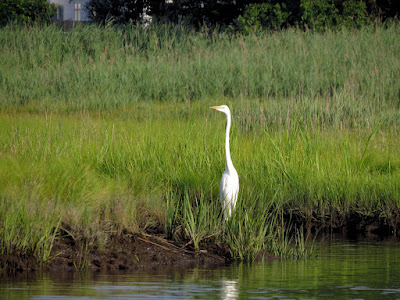Today was another one of those "blow the carbon out" days. I was busy for two days hanging an art exhibition and other than that the week has been a bit oppressive on the humidity scale. I also had a special request to bake a batch of lemon bars, so while they were in the oven, I loaded my gear for the quick getaway.
It's a very fine summer day and I put in on the big river for a trip down to the local big marsh. And while there will be a lot of big boat traffic on the river today, I will be where they are not, over by the bank dodging the incoming tidal current. It takes just about 20 minutes to get to the marsh. I've done it in under 10...all depends on the tides. Those sub 10 minute days kind of get your attention.
 |
| Juvenile Yellow Crowned Night Heron |
I head into the secret shortcut, which is recently my preferred route. It meanders, a narrow channel surrounded by tall spartina - the cord grass variety. I can't see far in here, but no one can see me either, and I've never seen anyone, ever, in here. At the high spot phragmite patch, I flush a half dozen Black-Crowned Night Herons, the most I've seen at one time this year. Three Night Heron juveniles and a dozen ducks also flush. I suspect that the juvenile Herons are Black-Crowns, but without a good look, it's hard to tell a Black Crown from a Yellow Crown. From there, I aimlessly wander toward Milford Point.
Of note, I have not seen any Short-Billed Dowitchers since the 17th of July, so they must have been on a tear to migrate south. It's interesting behavior that a bird would fly to the Arctic and migrate back as soon as possible, which just can't be long after their young fledge. Anyway, they are known for early migration. This quick stop over, which they seem to do out of easy viewing in the center of the marsh, might explain why the bird sighting count is so low for Dowitchers. In one day, I saw about 10 times what the shore based bird watchers recorded for the month.
There's a guy fishing at the point, and we both pause to talk. He asks me about the fishing and depth of water, and I tell him that all the fishermen that I've seen out here are on the river side of the point. He admits not knowing what he is doing and not particularly caring as it is so nice out. He passes my "good guy" test.
I head east around the bottom of the marsh. The inner corner is often a good spot for juvenile Herons, but not today. I spot a few more Night Herons before sneaking back into the shortcut. I explore one promising side channel, which forks into two dead ends...a bonus.
I head back up the river along the shore with a tailwind and the last of the flood current. The boat launch is busy with... well, just say that seamanship is an inverse relationship to horsepower. I take out on the bank next to the launch and vacate the premises.
























